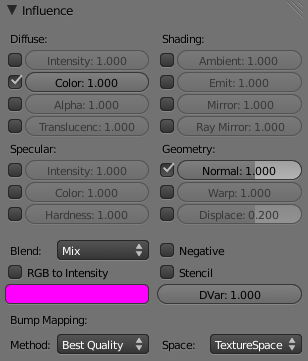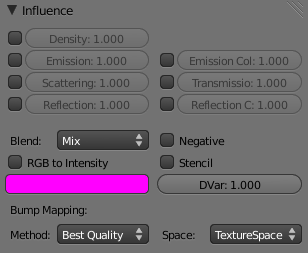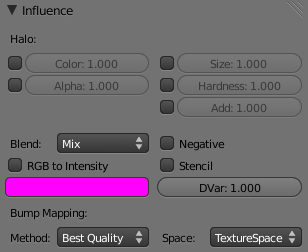Doc:2.6/Manual/Textures/Influence/Material
Material Textures Influence
Not only can textures affect the color of a material, they can also affect many of the other properties of a material. The different aspects of a material that a texture influences are controlled in the Influence panel.
Note
Texture options for Surface and Wire materials and in some cases also for Volume and Halo materials.
|
Surface and Wire materials
Diffuse
- Intensity
- Amount texture affects affects diffuse reflectivity
- Color
- Amount texture affect the basic color or RGB value of the material
- Alpha
- Influences the opacity of the material. See Use Alpha for Object Transparency. Also use Z Transparency for light and if combining multiple channels.
- Translucency
- Influences the Translucency amount.
Specular
- Intensity
- Amount texture affect specular reflectivity
- Color
- Influences the Specular color, the color of the reflections created by the lamps on a glossy material.
- Hardness
- Influences the specular hardness amount. A DVar of 1 is equivalent to a Hardness of 130, a DVar of 0.5 is equivalent to a Hardness of 65.
Shading
- Ambient
- Influences the amount of Ambient light the material receives.
- Emit
- Influences the amount of light Emitted by the material.
- Mirror
- Influences the mirror color. This works with environment maps and raytraced reflection.
- Ray Mirror
- Influences the strength of raytraced mirror reflection.
Geometry
- Normal
- Commonly called bump mapping, this alters the direction of the surface normal. This is used to fake surface imperfections or unevenness via bump mapping, or to create reliefs.
- Warp
- Warp allows textures to influence/distort the texture coordinates of a next texture channel. The distortion remains active over all subsequent channels, until a new Warp has been set. Setting the factor at zero cancels out the effect.
- Displace
- Influences the Displacement of vertices, for using Displacement Maps.
Other Controls
- Blend
- Blending operation to perform. See Texture Blending Modes for details.
- RGB to intensity
- With this option enabled, an RGB texture (affects color) is used as an intensity texture (affects a value).
- Blend Color
- If the texture is mapped to Col, what color is blended in according to the intensity of the texture? Click on the swatch or set the RGB sliders.
- Negative
- The effect of the Texture is negated. Normally white means on, black means off, Negative reverses that.
- Stencil
- The active texture is used as a mask for all following textures. This is useful for semitransparent textures and "Dirt Maps". Black sets the pixel to "untexturable". The Stencil mode works similar to a layer mask in a 2D program. The effect of a stencil texture can not be overridden, only extended. You need an intensity map as input.
- DVar
- Destination Value (not for RGB). The value with which the Intensity texture blends with the current value. Two examples:
- The Emit value is normally 0. With a texture mapped to Emit you will get maximal effect, because DVar is 1 by default. If you set DVar to 0 no texture will have any effect.
- If you want transparent material, and use a texture mapped to Alpha, nothing happens with the default settings, because the Alpha value in the Material panel is 1. So you have to set DVar to 0 to get transparent material (and of course Z Transparency also). This is a common problem for beginners. Or do it the other way round - set Alpha to 0 and leave Dvar on 1. Of course the texture is used inverted then.
- Bump Mapping
- Settings for bump mapping.
- Method
- Best Quality, Default, Compatible, Original
- Space
- Texture Space, Object Space, View Space
Volume materials
Special texture options for Volume materials
- Density
- Causes the texture to affect the volume's density.
- Emission
- Causes the texture to affect the volume's emission.
- Scattering
- Amount the texture affects scattering.
- Reflection
- Amount the texture affects brightness of out-scattered light
- Emission Color
- Amount the texture affects emission color.
- Transmission
- Amount the texture affects result color after light has been scattered/absorbed.
- Reflection Color
- Amount the texture affects color of out-scattered light.
Halo materials
Special texture options for Halo materials
- Size
- Amount the texture affects ray mirror.
- Hardness
- Amount the texture affects hardness.
- Add
- Amount the texture affects translucency.


